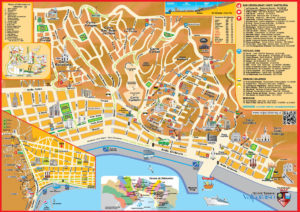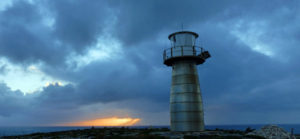Jennifer Burge's Blog
August 29, 2018
The Wrong Kind of Woman

When I began writing about my personal experiences abroad, I promised myself I would be as honest as possible. The main reason I wanted to write was to provide insight into the myriad of unexpected ways in which a person’s life is impacted by moving to another country. As someone whose life was profoundly changed by the experience in both positive and negative ways, I felt it was my obligation to share my stories with others so they would not be blind-sided.
Honesty is perilous when writing about your life. Every admission has proper timing.
I’ve written about whirlwind romances, office culture clashes, and travel nightmares. I’ve even gone as far as talking openly about how a particular situation had a devastating impact on my marriage. What I haven’t written about is the most difficult chapter of this globetrotting life so far: Australia.
I have authored numerous articles on the beauty of its landscape and the joy I experienced traveling throughout the sunburnt country, but I haven’t written about the circumstances that crushed my confidence.
Why didn’t I? Because it was humiliating. Because I’d stood up time and time again when the Dutch criticized my style of dress, working, and simply being. Because I’d survived four years in Singapore where my career was upended and I no longer knew who I was. How could it be that I had more severe problems living in one of the most beautiful countries on Earth where people are reputed to be so easy-going? Simple, because they aren’t.
Let me make one thing clear: I do not hate Australians. I do not have dislike for Australians.
And another thing: Not all Australians are the same.
When I write that my eyes were opened wide this week by a book about Australian / American interactions titled, A Fair Go for All by Dr. George Renwick please do not assume that I am an Aussie hater. My friendships with Aussies that have lasted for decades are testaments to that fact.
Last month, I met Dr. Renwick at the Summer Institute for Intercultural Education at Reed College in Portland, Oregon where I was a Fellow. We had not met previously and I was unaware of his extensive experience in international business prior taking his classes. I won’t pontificate on the impact this meeting had on me. I will say only this: It changed my life. The fact that another Fellow pointed out this book to me in the bookstore was not a coincidence. I was meant to read it.
Shocking statement number one: “the idea is still widely accepted that women exist to serve men.”The author goes on to provide examples of more modern thinking but please keep in mind this book was written in 1991. “Surely things have changed?” you might be thinking. The answer is yes, but they have changed very little.
There is no question that chauvinism is rife in modern-day Australia. Perhaps I would have questioned this before I witnessed the vulgar way in which Australia’s first female Prime Minister, Julia Gillard, was treated when I first arrived in the country in 2011. Or before I read the news last week that the most experienced candidate for the job this time around, Foreign Minister Julie Bishop, was passed over in favor of Evangelical Christian Scott Morrison whose personality loudly echoes Donald Trump’s.
Shocking statement number two: “Australia’s chauvinist orientation can pose problems for business or professional women from the United States who are assigned to Australia to work in traditionally male fields. The issue is further complicated if the woman’s position is in management.”
On this topic the author provides an illustration. “In a recent example, An American woman in personnel management was given a four-year assignment to the Australian office of a large U.S. multinational company. Ninety-five percent of the office employees were Australian, of which 75 percent were male. “The first two years,” she reported, “were nearly impossible.” If the office had not had an American (male) general manager, she would simply have gone home. The last two years were easier because the ground rules for gender relationships were gradually established.”
You could have knocked me down with a feather when I read this. I had no such American manager. What I had were a cohort of extremely aggressive Australian male executives and peers who went out of their way to bully me into submission. And what happened when I didn’t bow down to the intimidation? My professional life went from bad to worse. The company delivered its first anti-bullying training class to my office in 2011 and the label “troublemaker” was permanently affixed to my name.
Not too long afterward, I left the company to pursue writing. Living every day under the extreme stress was killing me. Unsurprisingly, I was far from the only female who exited stage left during my time there. When I knew I was reaching the end of my rope in 2012, I attended an International Women’s Day event held by the company. During the session, a live video conference was held with the most senior female executive in the company participating from the United States.
I raised my hand to ask a question. “What advice would you give to the younger women in the audience about handling the Boys’ Club?”
“Oh, I don’t think we need to spend time on that. I haven’t dealt with a Boy’s Club since the 90’s.” The hosting Australian female executive quickly brushed off the question.
The American female executive persisted. “I’m glad you asked. We should certainly address how to handle those types of scenarios if they occur.” She went on to provide strategies forcing inclusion.
If both women and men are loathe to admit that a severe problem exists, there is very little hope of solving it. A quick look into the frequency of domestic violence in Australia will illustrate that my professional challenges were minor in comparison.
Dr. Renwick writes that “Australian women generally seek and find fulfillment in the home.” To anyone wondering why I now reside in the United States rather than Australia where I also hold citizenship, I admit I am the wrong kind of woman to thrive in its culture. I would also be the last to tell you that the challenges of inequality in America are minor. There are men and women in both countries who are fierce advocates for diversity and inclusion in the workplace. My personal preference is to live in the one where my voice is not ignored.
Dr. George Renwick, A Fair Go for All (Intercultural Press, 1991); pg. 36
Dr. George Renwick, A Fair Go for All (Intercultural Press, 1991); pg. 36
Dr. George Renwick, A Fair Go for All (Intercultural Press, 1991); pg. 36
Dr. George Renwick, A Fair Go for All (Intercultural Press, 1991); pg. 36
March 6, 2017
Rocking the Granite Belt
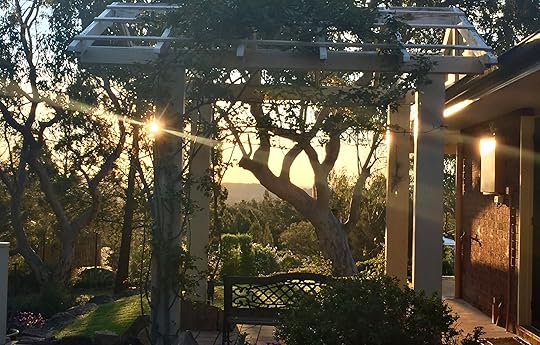
Initially, it was the ‘place of flowers’, Girraween National Park, which drew me to Queensland’s 5th highest elevation. Perhaps it was the desire to experience a bit of winter feeling that I’d long left behind, but without a doubt, the uniqueness of the natural terrain with its massive granite boulders and meandering Bald Rock Creek sealed the deal. The sheer number of beautiful walks for both amateur and advanced bushwalkers means that anyone can enjoy the day here.
If you’re in the mood for more adventure, try Sundown National Park—but I warn you this is not for the uninitiated four-wheel driver! Once you pass its gates, you’re on your own to navigate the extremely steep jagged trails that lead to Mount Lofty without much room to maneuver for fellow adventurers. Not in the mood to extreme fun? Simply drive Sundown Road from nearby Ballandean for a glimpse at hundreds of curious kangaroos and jittery deer, not to mention a prime sunset view if your timing is right.
But what if you aren’t a nature lover? Is there anything for you in the Granite Belt? I’m going to hazard a guess that even most people who aren’t wild about wilderness will go a fair bit out of the way for great food and wine. I know… I know, “Queensland doesn’t make any good wine.” Right? Well, I hope you didn’t place any bets on that assumption because I’m here to tell you that you’re going to lose a few bucks!
Though the area was first thoroughly explored and documented by Scottish botanist Alan Cunningham in 1827—many of the early settlers were Italian. Encouraged by the local Catholic priest, grapes were first planted here in the 1860’s to produce altar wine. Not considered for commercial development until a hundred years later, Granite Belt wineries have been sneaking up on the competition to be both domestically and internationally recognized since 2013.
Today, there are nearly fifty cellar doors in the area and I don’t have to tell you that for the average weekend visitor and even the most ambitious connoisseur, you’ll never visit them all. Having sampled a number of the local goods, I’d advise you to start with these:
Golden Grove Estate, Ballandean – highly-acclaimed reds and whites in the Italian style If you don’t try the Nero d’Avola and the Tempranillo, you’re missing out!
Tobin Wines, Ballandean—premium single-vineyard winemaker producing a gorgeous Chardonnay amongst several others
Boireann Winery, The Summit (near Stanthorpe)—red wine only, quality wines that will have you coming back for more, not to mention the super-friendly owner Peter who loves a good chat during the tasting
Have I enticed you yet? “No, tell us about the food!”
How could I forget the region’s cuisine with locally-produced stars of the show? I assure you I have not. If you’re not camping and four-wheel driving in this stunning countryside, you will not want to pass on some of the best food for miles around. Having traveled many miles on my stomach, these are my personal favorites:
The Barrel Room, Ballandean—truly unique dishes showcasing the best produce, free-range, and organic tastes of the area in a rustic farmhouse setting at Ballandean Estate Winery
Granite Belt Brewery, Stanthorpe—something for the beer lovers here, a microbrewery with great food to match. The owners’ witty sense of humour is on full display throughout the joint.
Mt. Stirling Olives, Glen Aplin—from plump olives with a Turkish flair to an outstanding cuppa with a taste of sumptuous homemade fudge, I dare you to leave without a bite for the road
Stanthorpe Cheese, Stanthorpe—need I say more? Unique and delicious. Sample or take a seat at the in-house Jersey Girls Café and prepare to indulge
Suttons Farm, Thulimbah—the best apple pie and cider for many a mile
The long and the short of it is that the Granite Belt truly offers something for everyone. Nature-lovers will be hard-pressed not to be awed by Mother Nature’s outstanding display of wilderness. Foodies will have plenty of variety to tempt their senses. Wine-lovers will want to come back for more. The only problem I’ve had is fitting it all in. Let me tell you, that’s one problem I’m happy to have.
Want to take these tips with you? Download printable Rocking the Granite Belt in .pdf here!
The post Rocking the Granite Belt appeared first on Worldwise Publications.
December 21, 2016
Where the Wild Things Are
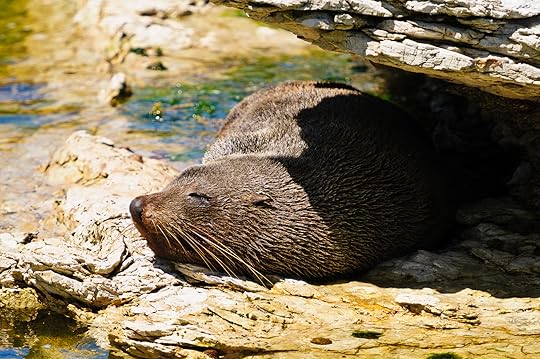
Actually, I should say it was fairly well-hidden until it made headlines when it was struck by a massive 7.8 magnitude earthquake on November 14th of this year. Just after midnight, a calamity was unleashed on this small South Island town of 3,800 people from which it is still recovering. Kiwis are known for their resilience and the “Shaky Isles” are no stranger to earthquakes, but the main attraction of this aquamarine peninsula has long been its wildlife. Researchers are only beginning to understand how they fared during and after the calamity.
Kaikoura was likely first settled by Maori tribes who hunted Moa close to a thousand years ago, but the rocky layers that make up the shoreline are known to have been raised up over eighty thousand years ago from the sixty million year-old ocean floor. According to Maori legend, Temaki-te-rangi came here hundreds of years ago when he stopped here to eat while chasing his runaway wives. He happened upon an abundance of crayfish and thus came the name “the fire that cooked the crayfish.” A place with origins like this is too fascinating to be ignored.
My personal experience in Kaikoura was during the Christmas of 2011 when I visited with my husband. I had read the brochures and guidebooks, but nothing prepared me for the picture-perfect peninsula. In general, I am a fan of natural remote places and if they offer the added bonus of wildlife, my happiness is certain. We drove south on Highway 1 from Picton on Christmas Eve after gathering supplies and well before we arrived at Kaikoura, we located Ohau Point. I’d read about the seal pups which could easily be spotted here within a five minute walk to a waterfall from the road, but we hadn’t even laid eyes upon the path when we discovered that the outcropping of rocks just below the road was littered with New Zealand fur seals. Truth be told, we smelled them before we saw them—but it didn’t matter. Low tide allowed us to walk around photographing the enormous beasts lazing in the summer sun.
Afterword, we found the short trail that would take us to the waterfall walk and, hopefully, the seal pups that were known to reside there. When it comes to wildlife, there are no guarantees. Unfortunately, the pups don’t wear watches to know when the tourist tide will rise and swell, so I expected to be disappointed. Luck was on our side this time, however, as there were pups sitting out in the open on the rocks.

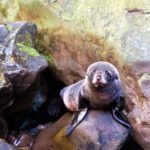
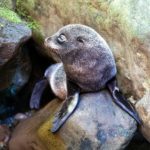
Huge round eyes that seemed to have difficulty focusing indicated either how young they were or that naptime had just finished. There was no way of knowing. But their brown fuzzy cuteness was undeniable. When more travelers appeared in a large group, we made our way out–smiles plastered to our faces.
All of this magic on Christmas Eve left us wondering what our Boxing Day dolphin swim would bring. It was a decision that I’d pondered over in the planning phase. I mean, I’d seen dolphins before many times—often in extremely close circumstances or in the water. Would this really be anything different? I was assured that it would be and we booked in to Dolphin Encounter.
Putting on a wet suit is not my favorite activity, but I will do a lot to mingle with marine life.
There were roughly 15 of us on the boat that day and as I struggled to get my suit on, I listened to an explanation of the experience by our guides. The local dolphin is the ‘dusky dolphins’ and they travel in pods of hundreds. At the time of our visit, the pods were numbering between 300 and 600. It blew my mind. The most I’d ever seen together was five or ten, but as I now knew—New Zealand is a place like no other.
As we cruised the white cliffs of the Kaikoura coast, we were assured that the dusky dolphins would appear shortly. Apparently in this case, it was all but guaranteed. An albatross flew past while I sat on the back deck looking for fins, gliding over us with an eight-foot wingspan. The distraction was short-lived as the guide shouted to get our attention and the boat turned toward the largest group of dolphins I have ever seen before or since.
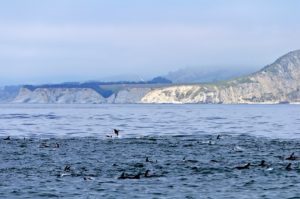
Dusky Dolphins at Kaikoura
I expected to have fun. I expected to enjoy the hell out of this experience. I did not expect the dolphins to enjoy it too—but it was obvious that they were loving making the swimmers dizzy themselves. I followed for as long as I could, stopping to snap photos with an underwater camera here and there, but they flat-out exhausted me. I loved every minute of it.
Are you wondering now what has happened to all these lovely creatures after “one of the most complex earthquakes ever recorded on land” happened in their neighborhood? I was too. Knowing those little pups and the fun-loving intelligent dolphins who loved to torture the tourists were there, I had to keep an eye on the results of the local researchers. I am incredibly pleased to report that the news is good. The seals have relocated and the dolphins have returned!
Though the number of aftershocks has nearly reached two thousand and the state of emergency was only lifted eight days ago, Kaikoura will recover. The town is working hard to restore as many services as possible and though we didn’t see them, it is known to be one of the best places in the developed world to watch sperm whales migrate and the right time of year. There is no chance I’ll skip returning to this place—it has been twisted over millions of years to its current magical incarnation and there’s no telling what’ s going to happen next. I, for one, will be there to find out. I hope you will too.
The post Where the Wild Things Are appeared first on Worldwise Publications.
November 4, 2016
Suspicious Salem
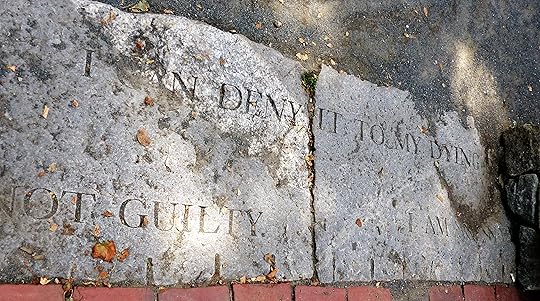
I admit it. The first time I came to Salem in 2000, my friends and I were drawn by the salacious stories of the Salem Witch Trials famously held here in 1692. We visited the Witch Museum. We checked out the spooky wares for sale in the tourist shops. It wasn’t until fifteen years later on my next trip that I discovered the rest of Salem’s history and found myself looking in the mirror at early Americans who traveled the globe to bring back their discoveries to one of early America’s powerhouse cities.
The tale of Salem begins in the year 1626 with roughly thirty settlers led by a man named Roger Conant. The group consisted mainly of Puritan fishermen who had left England for religious freedom. The Puritans were Protestants who felt that the Church of England wasn’t quite “pure” enough of Catholicism for their liking. But just because they were forming their own homeland didn’t necessarily mean any other faiths would be welcome. In fact, they were met with suspicion.
By June of 1692, one accusation released a tidal wave of hysteria across the town. The spark was an accusation of witchcraft by three young girls displaying highly unusual symptoms that couldn’t be explained by disease. It wasn’t the first case of witchcraft and is today hypothesized as having been the result of a family feud. Regardless, three women were tried, convicted, and hanged at Proctor’s Ledge for the crime of practicing witchcraft. In this highly-religious society, nothing was more terrifying of those who appeared or were rumored to be possessed by the Devil. Nine more women and seven men followed in the footsteps of the initially accused and one died in prison. 150 men, women, and children would also stand accused, but were not convicted. By September, the drama had largely played out.
Though the court of Massachusetts later officially overturned those deadly verdicts, it was hardly of any use to the dearly departed.
Transcripts of the trials were largely based on the presumption of guilt and a great deal of hearsay from the villagers. Judge Jonathon Hathorne, later known as the “Hanging Judge” pursued the following line of questioning with Rebecca Bishop:
Bishop, I am no witch
Hathorne, Why if you have not wrote in the book, yet tell me how far you have gone?
Bishop, I have no familiarity with the devil.
Hathorne, How is it then, that your appearance doth hurt these?
Bishop, I am innocent.
Hathorne, Why you seem to act witchcraft before us by the motion of your body which seems to have influence upon the afflicted.
Bishop, I know nothing of it. I am innocent to a witch. I know not what a witch is.
Hathorne, How do you know then that you are not a witch?
Bishop, I do not know what you say.
Hathorne, How can you know, you are no witch, and yet not know what a witch is?
Bishop, I am clear…
The Salem Witch Trials Memorial to the twenty people who died after being branded as witches was constructed and dedicated to those now widely-acknowledged as innocent in 1992. Three hundred years after their deaths, the voices of the accused call out to us from etched granite near Salem’s Cemetery. I couldn’t help but be saddened reading their desperate pleas from beyond the grave.
“I am innocent”
“I am wronged”
“Oh Lord help me. I am wholly innocent of such wickedness”
“I can deny it to my dying”
Though police and city employees today wear an insignia on their uniforms which includes a witch on a broomstick and you can stroll the grounds of Witchcraft Heights Elementary School, there is more to see here than the story of some very unjustly treated women. You can also walk through the Chestnut Street District which is home to the greatest concentration of 17th and 18th century domestic structures in the United States. You can tour the House of Seven Gables, where Nathaniel Hawthorne—a distant relative of the hanging judge—wrote one of his most well-known works and is today a strikingly-well restored and fascinating museum.
Of course you should also visit the bookshop where I was lucky enough to have a book signing on Salem’s main pedestrian street, Wicked Good Books. And you cannot miss the PEM, Peabody Essex Museum, America’s oldest continuously operating museum since 1799 which holds fascinating artifacts brought from around the world by sea captains and intrepid voyagers in the early days of oceanic exploration.
To summarize, what we have here are a number of women and men who were grievously and fatally wronged by America’s infant justice system. More specifically, a group of male patriarchs who were hell-bent on preserving the “purity” of their community by alleviating it from the presence of those they deemed undesirable. Men who thought it their right and indeed their destiny to brand these innocent men and women with charges they could not fight.
It’s worth noting that three hundred years after the fact, it is not the wealth of the 6th largest city in the colonies that is remembered. Nor is it the many treasures of early American culture and history that can be found here. It is one of the greatest witch hunts of all time that is first and foremost on our minds. One has to wonder if the year 2016 won’t be remembered for exactly the same reason.
The post Suspicious Salem appeared first on Worldwise Publications.
October 28, 2016
Vivid Valpo
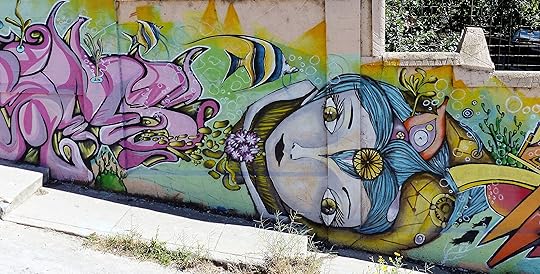
Striking colors and steep hillsides packed with historic neighborhoods, Valparaiso is in a class by itself.
I didn’t think we would manage to park the car without major drama. San Francisco has nothing on these steep streets that are often more like sidewalks and space is difficult to come by in any form. We navigated numerous blind ninety-degree turns and miraculously landed in front of our hotel at the top of the hillside. A smiling employee appeared to tell us that he would park the car. We only needed to call ten minutes ahead for them to collect it when necessary. I wanted to kiss him.
Valparaiso is Chile’s sixth largest city, sitting seventy miles (111 km) northwest of Santiago. It has a rich past due to its location on the Pacific Ocean and was enjoyed numerous powerful visitors and enterprise as a major stopping point for ships traveling between the Atlantic and Pacific via the Straits of Magellan. The main focal points of the city today were constructed in the post-independence boom of the early 1800’s.
While the Spanish had been the first Europeans to arrive in 1536, there is a multicultural mix to the architecture lent by the numerous cultures who landed and created their own neighborhoods. These are today preserved as “zonas típicas”. The city’s incredible architectural diversity lent itself readily to its resurgence in the early 2000’s as an artists’ haven.
Through one hotel window of our hotel, I looked over the Port of Valparaiso for the first time. A port that manages ten million tons every year isn’t expected to be beautiful, but the sapphire sea sparkled below. I couldn’t wait to step out and explore, but our trip had been long and the bed called loudly. The next morning, I took in the view from another window and had a strikingly different sensation. Here I was in a gorgeous whitewashed five-star hotel, a splurge for our ten year anniversary, looking onto properties that looked like they wouldn’t survive a strong gust of wind let alone the earthquakes that are common in the region. It made me feel guilty.
At breakfast, the girls who worked the dining room were cheerful. I thought I even heard singing coming from the kitchen, but I was too distracted with the plans of the day to pay much attention. New territory called my name and Valparaiso was a puzzle I’d attempted to solve since booking our trip a year before. It’s difficult to figure it out from a distance and, as it turns out, it isn’t much easier in person. A quick glance at the map will explain.
Tourist Map of Valparaiso Chile
Undeterred, we headed out to try and find our way. The massive incline of the city streets hadn’t magically flattened overnight and even in the October sun, climbing the cities numerous staircases was challenging. This is a town famous for its funiculars, but I’ll be damned if I could find one! Bemused neighborhood cats looked on with boredom, laughing at us as we tried to catch our breath.
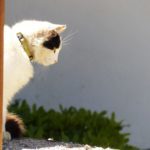
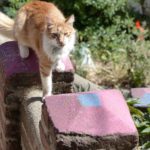
When I stopped noticing the cats in the street, I noticed them on the arresting street art that fills the city. Were cats revered in ‘Valpo? What was the deal with all the gatos anyway? Like much about Valparaiso, I never did figure that out. The art, however, is so amazing that it will stop you in your tracks. At the top of one funicular (hurray we finally found one!), this woman watched me from the side of a building.
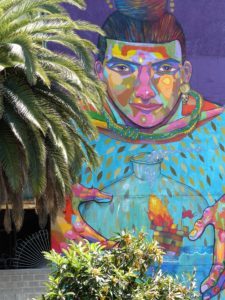
Good vs Evil?
Paradoxical in nature yet beautiful to the eye—I found it impossible to look away.
From the top of the city on Monte Alegre, we visited the Palacio Baburizza, a mansion in the clouds built as a residence by a wealthy Croatian businessman in 1916 by Italian architects. Now the Fine Arts Museum, it is a work of art containing an impressive art collection within its walls. Personally, the building itself was what I found most fascinating. In a gothic-meets-art-deco way, it is one of the most unusual buildings I’ve had the good fortune to come across. Finally disregarding the map, we wandered through the Plaza Sotomayor and found the home of the first Chilean Navy near the port. The city’s color theme never disappears, not in the official buildings and not even in the city’s fishing fleet.
An article on this burgeoning artistic commune would not be complete without a single note of caution. Theft is rampant and can sometimes be violent. Fifty dollars disappeared from my hotel one morning when I stepped out for a mere thirty minutes without putting my wallet in the safe. Our waiter at dinner one evening tried to get himself an extra-large tip. Two policemen grabbed me at the Hotel Gervasoni, a tourist mecca, and told me to put my camera away because it wasn’t safe.
Wherever tourists with a bit of money mix with a struggling local population, this will happen. While it didn’t ruin my trip, it definitely gave it an awkward angle. Valpo is a happening place with an eclectic vibe that will continue to reinvent itself in the years to come. Pack a bit of sensible caution in your travel bag and do not complain about the few minutes’ inconvenience of using the safe–and you will be richly rewarded by what the city has to offer. Street art is beautiful, but you shouldn’t have to pay to look at it.
The post Vivid Valpo appeared first on Worldwise Publications.
October 14, 2016
Incredible Innes

We had four days left of what had been a spectacular South Australian road trip and intended to finalize it at the Yorke Peninsula. I knew nothing about the place as information online was sparse but the recommendation came from a trusted native of the state. The destination was Marion Bay, mostly because of its proximity to Innes National Park. Driving from Adelaide, we made a stop at Minlaton to get a few groceries. We’d been fighting the strong winds all day, but now a threatening dark sky joined the party.
“There’s no way this can be good.” My thoughts were as gloomy as the clouds above. The three-hour drive did little to change my mindset. Sand dunes, the occasional house or factory, and a great deal of farmland didn’t match the vision in my head in the slightest. An occasional view of the angry southern ocean allowed hope to flicker. The best part of the day was getting our bags, gear, & supplies into our rental house before the heavens opened and dumped all available precipitation on us. The wind was a ravenous wolf that howled all night long, shaking the house.
At the visitor information center of Innes National Park, which sits aside Marion Bay at the southwest tip of Yorke Peninsula, the friendliest ranger I’ve ever met told us that it was a good time to spot baby emus, or in her words “stripeys.”
“And don’t miss the sunset at West Cape. The sun’s rays reflect off the lighthouse and it is an amazing view!” Her enthusiasm was infectious.
We made notes on the map she gave us and paid the entrance fee. Optimism played hide and seek between the clouds. I charged my camera batteries and hoped for the best.
The next morning came with sunlight—defying the weather report. My husband and I walked around Marion Bay to check out the village before investigating the park. As we stood on Penguin Point looking over the vast ocean filled with silvery sunlight, my heart lifted. The wind was still with us, but the rain was holding off. After a few photos of the early morning fishermen, we headed for the park. All I could think about was finding the stripeys.
The first highlight near the park entrance is Stenhouse Bay which has a stunning jetty reaching out over the emerald sea. Just as we got out of the car to have a look, the rain decided to pummel us. Simply rain or wind alone rarely stop me from hiking. The combination, which makes photo-taking impossible, usually puts an end to my plan. In this case, we drove on to see what else we could find. I’m pretty sure that was all according to someone’s plan because the next thing I saw was a very large emu walking straight towards me. He wasn’t threatening, just extremely curious. As I sat there collecting video, I realized how much fresh emu poo was on the road. This guy apparently had lots of company. See him here.
As we drove on to Cape Spencer, rain subsided but the wind kicked it up about ten notches. With the rolling ocean below mixing up foam and waves like I have never seen before, we fought our way to the lighthouse. I am not a small person and I’m telling you it was a fight. I kept thinking how glad I was that I didn’t have any small children because I was knocked off balance more than once! The view, however, was worth the effort. More video, more shared smiles with my husband. Without saying it (because it was nearly impossible to talk!), we knew we were onto something good. Blown away by Cape Spencer video
Back on the gravel road, we happened upon a whole group of emus—causing me to Google, “What do you call a cluster of emus?” Again I took out the video camera as the mob of emus (yes, really, a “mob” is the correct term), ran off over the cliff like the Keystone Cops. It was thrilling to see so many at once when before we’d maybe found one or two together at most. The mob consisted of at least ten birds (video link). Perhaps they put the word out that we were harmless as they ran off because around the next corner, finally, a mother and her baby walked roadside without too much concern for us. The stripeys are beautiful little creatures with white racing stripes and short, fuzz-like feathers. The must have been staying out of the wind or this little guy would have been sent flying. 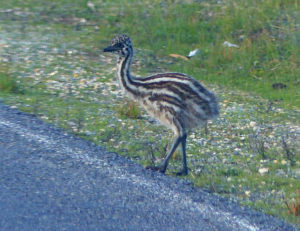
But the surprises didn’t end there. We found ourselves looking onto a large gray lake with houses around it and decided this must be the “ghost town” we’d been told of. As we decided to take a closer look at Inneston, the mining colony that had once been the home of 200 people, the sun flipped on its power switch. The lake, which had been dull and dark a few moments before was now shining a brilliant blue. The difference was remarkable. Reading the historic markers, we learned that this had been a gypsum mine until the 1930’s. That was the reason for the mesmerizing sparkle.
While Innes National Park isn’t a massive park like others we’ve been to, it holds some of the most dramatic coastline I have ever seen. There is nowhere this is more apparent than West Cape. We’d come to investigate our sunset spot, but ended up finding a picnic spot that we simply couldn’t leave. I must have taken at least a hundred photos of the lighthouse and the surrounding scenery—trying to make sure I would never forget it. When we came back that evening to capture the setting sun, I cannot ever remember being so cold and so happy at the same time. Two kangaroos bounced past and I watch my husband set up his tripod from below before joining him. There is no other word for it but thrilling.
Besides learning what a baby emu looks like and just how powerful the force of the southern ocean is, I realized how often I jump to incorrect conclusions. I’d been thinking that we would be stuck inside for the remainder of our days together when in fact, the Yorke Peninsula literally blew me away. I cannot remember a time when I’ve been so incredibly wrong about something having to do with travel but I won’t soon forget it. Perhaps that’s the reason this place made such an impression on me to begin with, because my expectations were so low. I don’t plan on going around expecting the worst, but I will sure as hell remember to keep hoping for the best.
The post Incredible Innes appeared first on Worldwise Publications.
October 6, 2016
Naturally Noosa
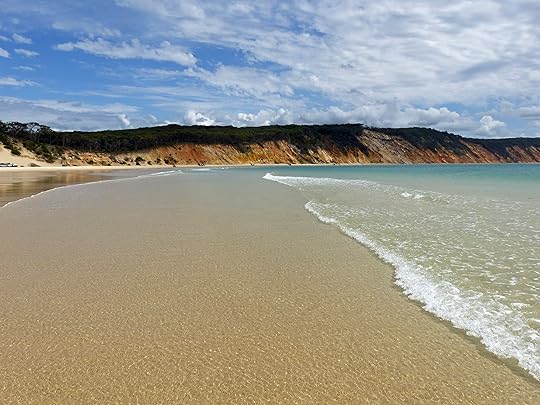
Who would have thought that now—200 years after Captain Flinders—many of us would be delighted by a naturally pristine coastline where not much exists? Given that what he was looking for (natural resources such as timber, good pastureland, and fresh water) and what we look for on holiday or for the sake of discovery are vastly different things, it probably isn’t too surprising that we would look upon the Noosa North Shore wearing different lenses. Mine, Ray Ban if you must know, are all about this barren coastline of extreme natural beauty whereas Flinders didn’t stick around long. Had I been a cartographer in the days of Cook and Flinders, I suppose I’d be very tired of all this white sand and crystal-blue water. This may well be the first time I haven’t wished for a time machine.
I have written and photographed Noosa previously. One can hardly live in Queensland without noting this crown jewel on the Sunshine Coast—even when I nearly drowned there from my own ignorance. You can read that embarrassing story here. Since moving to a town north of Brisbane a few years ago and becoming the owners of a proper four-wheel drive vehicle, my husband and I have chosen more and more to eschew the crowds of Noosa proper to head toward its spectacular North Shore instead. Much of it is no longer barren, but it hasn’t been developed either. In keeping with Noosa’s drive to maintain an ecologically sensitive existence amongst the mad tourism it attracts, large areas have been designated as reserves and parklands—including the Cooloola Recreation Area designated in 2010.
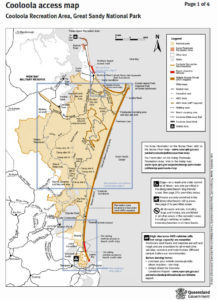
Cooloola Recreation Map, Queensland Park Service
Driving on the beach is something I hadn’t known was possible until moving to Queensland in 2011. Once we learned about it, we were eager to “give it a go” (another Aussieism). Our early adventures were a mixture of beginner’s luck, hair-raising excitement, and “we’re never doing this again!” Note: check your tide maps and plan accordingly!
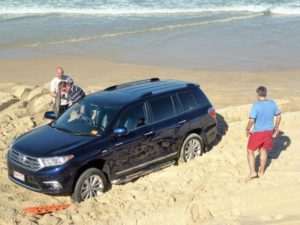
Beach Driving isn’t always easy, Stradbroke Island 2012
This particular adventure was not in Noosa, but on nearby Stradbroke Island and the car was an all-wheel drive, not a 4WD—an important distinction.
By the time we discovered Noosa’s forty kilometers of open beach driving called Teewah Beach, we’d learned the most important lessons and we were ready for beach camping at Cooloola. As with any outdoor activity, however, there are always more lessons to be learned. This lesson is called, “Check the storm activity carefully before setting up a tent on the beach.” On the plus side, we discovered that our tent is completely watertight!
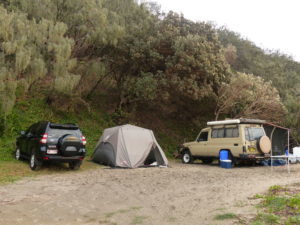
Teewah Beach Camping, 2014
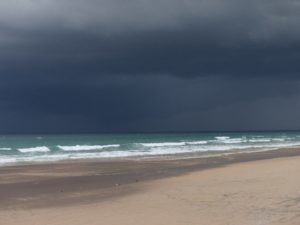
Mother Nature isn’t happy, Teewah Beach camping 2014
While we had far more adventure that night than we bargained for, we were undeterred.
The next day, when the sky returned to a color that wasn’t terrifying but a rather beautiful shade of blue, our more experienced friends led us further to Freshwater Campground and to Double Island Point. At the latter, it was love at first sight. This is the kind of place you have to struggle with yourself over wanting to share and wanting to keep very quiet. Its allure is its unspoiled beauty and relative isolation. There are no discarded potato chip bags flailing around on the beach, no soda bottles bobbing in the translucent waters. The worst imaginable fate of this place would be its transformation to “civilization.” You won’t find a takeaway shop or a petrol station but you will be able to appreciate how remarkably beautiful Queensland’s coast truly is. And honestly, what else do you need besides that and your swimsuit? Okay, you can have a towel too.
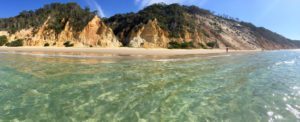
View of Double Island Point from the ocean
The Sunshine Coast, the area where Noosa lies as well as many other surprisingly beautiful beach communities, prides itself on being environmentally conscious. Though development came to the region in the early 1900’s and it has slowly progressed to the mecca of tourism that it is today, it remains the beneficiary of a legal battle in the 1970’s. A certain Mrs. Marjorie Harrold who led the Planned Progress Group fought hard against allowing high-rises on Noosa’s main street—Hastings Street. Initially, the group lost that fight, but the decision was reversed in 1972 making them illegal. As the region’s star appeal is its unique ecosystem and natural diversity, fighting to retain Mother Nature’s influence was critical. The introduction of free buses during peak holiday periods to reduce congestion and environmentally-friendly sewerage systems have served to advance the cause as well as numerous other local initiatives.
European settlers have lived in the region for roughly 150 years. Prior to that, Aboriginal tribes thrived here for many thousands of years living in harmony with the land. In total it has taken over two million years of shifting sand, changing sea levels, and weather patterns to create the dunes that we enjoy today. There are a total of eight different systems in the reserve area of varying ages. The oldest is approximately 500,000 years old. I had always read that dunes are known to be fragile, with possible shifting at any given time—but these hardy, wise dunes have seen more than we will ever know. Perhaps that time machine isn’t such a bad idea after all.
Note: For more about navigating the Cooloola Recreation Area, visit the extremely comprehensive Queensland National Parks Service Web Site.
The post Naturally Noosa appeared first on Worldwise Publications.
September 28, 2016
Cu Chi Crazy
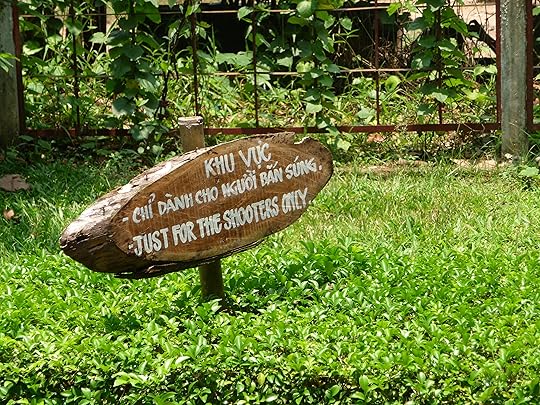
The first time I went to Vietnam, I worried a great deal about traveling there as an American. I wondered if I would be hated on sight because my nationality was the same as one of the foreign militaries that had invaded their country to back one side during a civil war. Additionally, I wondered how I would feel visiting a country where so many Americans had lost their lives. Was traveling there even the “right” thing to do? I had so many unanswered questions.
It turns out that I needn’t have worried. Whatever the Vietnamese may feel about Americans, they are happy to take our money. They equally happy to showcase our stranded war possessions and to put the evidence of the horrific effects of napalm on display for all to see and judge. We shouldn’t feel singled out, however, a guillotine sits in the Hanoi Hilton (aka Hỏa Lò Prison) to demonstrate the evils of the colonizing French in the 1800s. While the men responsible for creating these museums might be able to make a persuasive argument in English or French, the visual images are extremely powerful.
The Cu Chi Tunnels are something else entirely. The Cu Chi district of southern Vietnam is just over an hour from Ho Chi Minh City, formerly known as Saigon. The tunnels are part of an underground network that extends for 75 miles (120 kilometers) and was used for the movement of supplies, protection during air attacks, and basic survival. The government of Vietnam opened and restored them as a tourist attraction and there is no doubt that they tell a compelling story.
The Vietnamese were under-armed a not able to match the fire power leveled at them by Western forces. Instead, they used ingenuity and determination to fight back—along with a far superior knowledge of their own country’s terrain. The tunnels, constructed by hand with simple tools, were a major advantage. Originally built to defend themselves against the French, the tunnels were expanded during the Vietnam War. The have now been further expanded, but in peace time and to accommodate the larger size Western tourists who visit by the busload.
Also on display around the tunnels are the many rudimentary booby traps set to catch foreign soldiers. Just one look at these contraptions filled with metal spikes, machetes, and nails will tell you all you need to know about the types of agony they inflicted before the captive ultimately perished. Inside the tunnels themselves, the Vietnamese also suffered. Forced to live underground for sometimes months at a time, they shared their homes with poisonous snakes and centipedes. Disease and parasites were also rife. Malaria was the second major cause of death in the tunnels. As over forty thousand Vietnamese perished defending these precious tunnels, you don’t have to guess the first.
If you’re game, you can go into the tunnels (the expanded version) and take a walk—more like a crawl—through a small portion of it. Attention all claustrophobes: DO NOT ENTER. Even if you aren’t claustrophobic, it is a very tense proposition. The military “tunnel rats” who explored the tunnels to root out the Vietnamese often spoke of the feeling they had crawling through these minute spaces. They called it the “black echo.” I don’t know about you, but I don’t need to know any more than that!
As our visit wasn’t during wartime, I was startled to hear the sound of automatic weapon fire.
Once you explore the tunnels and have your sanity check by crawling in, you can go on to the weirder part of this weird attraction—the shooting range. You’ll need to queue up and spend a small fortune on the bullets, but on the menu to try are the AK 47, the M 16, the K 54, the AR 15, and others. The guns are all tethered to prevent someone from taking the weapon and firing against the crowd, but this is set up as just another “fun” wartime activity. Yes, seriously. Knowing that we would never have another opportunity in this lifetime to do it, our gang of four got right in line behind the rest of the parents and kids. (Again, yes seriously). My husband and I chose the cheapest option, the AK 47. Prices are per bullet, so it adds up quite quickly. Tall piles of bullet casings littering the ground leave little doubt that this is a very popular activity.
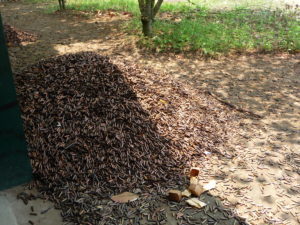
Gun enthusiasts rejoice: Cu Chi Tunnels offers up the ammo.
Pick up a Cu Chi t-shirt or Vietnamese flag at the gift shop which is conveniently located in the same building as the shooting range and you’ll have your bases covered. Not sure what to get Aunt Ethel for her birthday today, well, why not a round of ammo for the M 16? She certainly can’t call you a cheap skate!
The thing that I loved most about living in Asia is never knowing what’s going to happen. It is absolutely unpredictable in so many wonderful and quirky ways. I’m not trying to make light of war or weapons with these words, I’m merely trying to share the enthusiasm with which the Vietnamese have decided to illuminate a dark past and make history come alive for all of us. There are no end to the horror stories which emerged from the Vietnam War but far be it from me to say how they need to be told. If only to admire the steely psychological determination of this culture, and have a few uncomfortable laughs—this is an attraction not to be missed.
The post Cu Chi Crazy appeared first on Worldwise Publications.
September 22, 2016
The Veracity of Versailles
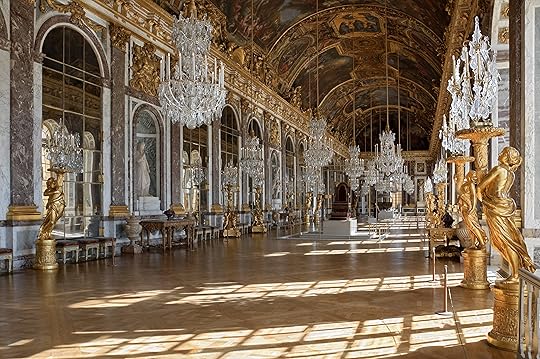
The Palace of Versailles sits a mere thirteen and a half miles (22 kilometers) from Paris proper. It is an easy train ride and fascinating day trip for any visitor. Five million people enter the chateau each year and double that number stroll the gardens. There is no place on earth that matches its grandeur, perhaps fitting for the legacy of the longest reigning monarch in European history, Louis XIV. A trip to the former seat of power for the Kingdom of France will have you marveling at a level of vanity and power unmatched in modern history. There’s only one problem–the character of the king responsible for this architectural masterpiece might leave you just a little sick to your stomach.
I have been fortunate enough to visit Versailles on more than one occasion. That’s quite lucky because my first sight of it (at the age of seventeen) blew me away. It was the second castle I’d seen in my life and I was still trying to comprehend that people once lived in such luxury. I was walking in the footsteps of kings, queens, and nobles—but my gilded surroundings were absolutely incompatible with anything that resembled a “home” in my mind. They simply didn’t come in something that measured over seven hundred square feet and included seven hundred rooms. What would someone—anyone—need with sixty-seven staircases and twelve hundred fireplaces?
My seventeen-year-old brain shut down and I labeled it all inconceivable even though I was standing in the undeniable proof of such an existence.
Learning about Le Roi Soleil (the “Sun King”), as I studied French was little more than memorizing dates, artworks, and artists. There was no subtext to the man who ruled his court with an iron hand. Yes, I was clear on the fact that Louis XIV is the leading global example of “absolute monarchy.” I also understood that he had spent immeasurable sums of money converting his father’s hunting lodge to the landmark it is today and in the process angered both his court and populace. But how bad could it be if he never had to pay the price for such extravagance. We’d have to ask Marie Antoinette about that one.
Last year, French television company Canal+ partnered with the BBC to create the most expensive French program ever aired. The gorgeous clothes, the elaborate games and entertainment—all in HD in their backstabbing glory for us to witness, providing more context for this king than anything I’ve ever seen. Simply titled, Versailles, it provides more clues to the danger involved with being in the king’s favor, let alone being out of it. It is said that Louis XIV earned his nickname by comparing himself to the sun—he believed the state could not survive without him. Other legend has it that the name was given to him by his courtiers who declared how warm it was in the king’s embrace and how very cold were those left out of it.
To imagine the life and mind of Louis XIV, envision a court numbering five thousand people—every one of them constantly vying for his favor. To control them, he demanded that they spend time at Versailles every year. With regularity, he also demanded they buy entire new wardrobes of the finest French couture at their expense. No less than one hundred people were called on to attend his daily Levee, which included him waking, having breakfast, bathing and dressing. If you were the absolute favorite, you were in attendance for the Grand Entrée and designated as the man to hand him his shirt. At the evening meal, an average of twenty-eight dishes were prepared and served.
Here we have the ingredients for seventeenth century “office politics”—only you weren’t free of your competition when you went home at night. Instead, your enemies—seething with ambition and jealousy—might be installed in the apartment right next to yours. It is an established fact that the nobles fought over the rights to neighboring apartments to keep their allies close. The only upside of residing at Versailles was that you had easy access to the latest news and gossip. All of which could be used as leverage against your adversaries! Jostling for position was constant during the fifty-two-year building project that transformed a somewhat modest hunting lodge into a monumental seat of power. Sounds like fun, doesn’t it?
Today, everyone can witness the extravagance Louis thought himself entitled to. The Hall of Mirrors (Le Galerie des Glaces) is one of the more striking examples. When the palace was under construction from 1661-1715, mirrors were one of the most expensive possessions one could own. The Venetians had a monopoly on the trade secrets of their creation and did not willingly or cheaply divulge them. Regardless, the French Finance Minister convinced several Venetian artisans to come to France to create and install two hundred and forty feet of mirrors. Venice then sent assassins to kill the artisans so proprietary secrets would be safe. Nothing or no one would stand in the way of the king’s admiring of himself.
Even without entering the King’s former home, you can experience its supreme beauty by visiting the surrounding gardens. Two thousand acres of landscaped French perfection await those who wish to stroll the outward reflection of the Bourbon dynasty. Visit the Orangerie which houses over one thousand plants, many of them orange trees which Louis’ gardeners managed to cajole into blooming year-round. Don’t miss the statue of Enceladus, Bassin d’Encelade (1675), a Giant of Greek mythology. The enormous gilt-bronze statue shows the giant, known for creating earthquakes and volcanic eruption, clawing with massive fists out of his earth-filled tomb—much in the same way Louis clawed through tradition to create his substantial legacy. 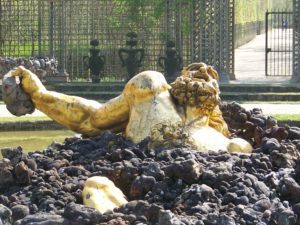
No matter how spend your time during your visit The Palace of Versailles, sensory overload is impossible to escape. A feast for the imagination in every sense of the word, the chateau delivers the sensation of a bygone era. But imagine–just for a moment–a man who believes he absolutely entitled to the best of everything, including (by modern estimates) a two billion dollar expenditure of other people’s people’s money and the unending sacrifice of everyone around him to serve his immense ego. We can hope that the world sees a man like this just once—but unfortunately, history does tend to repeat itself. The responsibility to police it is ours.
The post The Veracity of Versailles appeared first on Worldwise Publications.
September 15, 2016
Get Your Kicks on Kangaroo Island
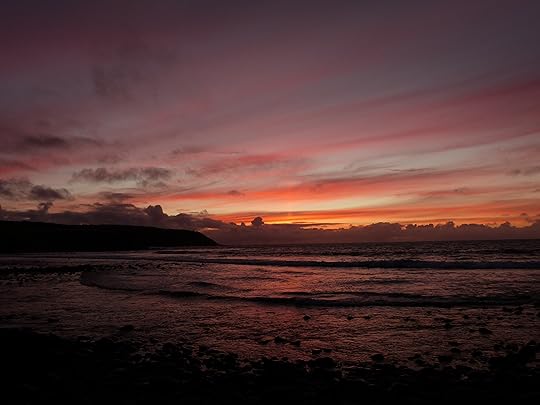
When I first visited South Australia in 2013, Kangaroo Island hit my radar. Descriptions of pristine wildlife and turquoise beaches refused to be ignored. I was in the state for the Adelaide Writers’ Week, so making the most of the fifteen hundred mile journey was just smart traveling. That was my excuse anyway. For the next three years, I waited for the opportunity to return and show it to my husband. Eventually, I got tired of waiting and created the opportunity last month. Carpe diem, right?
To access Australia’s third largest island is pretty simple. In barely more than one hour from Adelaide, you’ll be at Cape Jervis where the ferry departs. It’s the ferry cost that can be prohibitive. Well, that and the notoriously rough seas of the Backstairs Passage. For a vehicle and two passengers, the cost was nearly $400 AUD ($300 USD). I’ve taken a lot of ferries in this country and this is the most expensive by far.
For this trip we offset the cost a bit by renting an island house in the off-peak winter season. There are many available on Stayz.com. Bonus, winter is whale migration season! We picked a two-bedroom house with a nice deck and a BBQ at Vivonne Bay. Do you believe that on our first afternoon of arrival, we were waved at by a southern right whale and her calf five hundred feet from the beach? I cannot remember being welcomed anywhere quite so beautifully. I managed to catch the wave on video .
Kangaroo Island is 93 miles (150 km) long and 35 miles (57 km) wide—just big enough to offer a variety of things to see and do while never losing that remote “island” feeling. You can easily traverse the island (mostly) in a normal car without any need for a 4WD. Road improvements have been made in the less-traveled areas in the three years in between my visits to the chagrin of one lighthouse-keeper who shall remain anonymous. He told me a few years ago he hoped they would never improve the road to his lighthouse because too many people would show up. Given that one of the island’s best attributes is its unspoiled natural beauty, I understand his point completely.
The island highlights vary slightly depending on your personal taste, but one remarkable spot that can be enjoyed by nearly everyone is Seal Bay Conservation Park.
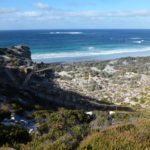
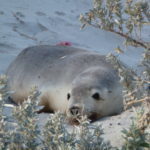
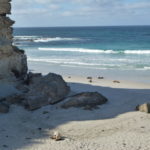
Completely unique on the planet, the conservation area allows you an intimate peek into the bedroom of a huge Australian Sea Lion colony via guided tours and an extensive wooden boardwalk. You can watch their antics independently or take a who-knows-what-will-happen tour walking through their beachy lair with a park officer. Interesting fact: sea lions are distant cousins to canines! Watching them, there is no doubt about it: Seal Lion Play .
Flinders Chase National Park is another KI (as the locals call it) “must do.” As a devoted fan of national parks the world over, I know a good one when I see it and this is one of the best. You can spot koalas in the car park, watch New Zealand fur seals nap on the rocks at amazing Admiral’s Arch, and ponder the life of the early colonists as they maintained the gorgeously remote lighthouses. Oh, and don’t forget Remarkable Rocks where you can ponder the power of the southern ocean and the fascinating shapes it produces. If you are very, very lucky, you might even witness Kung Fu kangaroos at Snake Creek!
Deserving of its own mention within the park is serene Cape Borda, located in the northeast corner of the island. The Cape Borda lighthouse is the absolute picture of tranquility, well, aside from the weekend firing of the cannon to amuse the few tourists who actually make it here. Even though Borda is inside the Flinders National Park site, it is out of the way and most visitors don’t have or don’t take the time to visit it. What a mistake that is. I have been here on both visits and the first time I spent the night in the park’s heritage accommodation. As the full moon and the sweeping beacon lit up the night, I was in awe of my surroundings. On my second visit, I couldn’t help but notice how completely chilled out the Borda wildlife is. Two wallabies with their little joeys didn’t mind me poking around one bit.
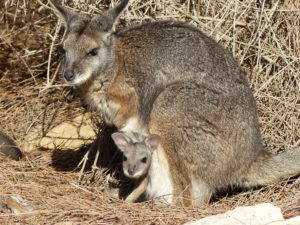
Chilled Out Wallabies at Cape Borda
But wildlife and natural beauty are not all that KI offers. You can sip some lovely wines at the stunning Dudley Winery cellar door which happens to also serve up extremely tasty wood-fired pizzas. The friendly folks at Bay of Shoals winery will gladly pour you a tasty drop along with a side of history. Fancy a cocktail? Head straight over to KI Spirits to beautifully quench your thirst with a Wild Gin and tonic or one of several other delicious concoctions. But the biggest surprise foodwise? KI True Thai! Imagine a very large shed in the middle of nowhere with the best Thai food truck, the friendliest people, and live music—there you have KI True Thai.
Now that I’ve shared all the facts about this incredible island that I can comfortably fit into a blog, I want to tell you about what you cannot see. Known as the “Island of the Dead” by Aboriginal people who inhabited the island first and for thousands of years, KI has an energy that you cannot put into words. I could call it “intriguing” or “electric” but that wouldn’t do. It has its own spirit, one that sensitive people cannot help but recognize and even those who aren’t will be left scratching their heads over. Perhaps it’s because this is the land where legend says Aboriginal souls return to when they die. Or maybe there is some complex geo-magnetic reason for it all. I will never know. What I do know is that this is a place that makes dreams come true. Make sure you have one ready when you visit. After all, that’s just smart traveling.
(Author’s Note: Sorry to leave you hanging on that last part folks! You’ll have to read my next book–about Australia–for more dream-come-true details… )
The post Get Your Kicks on Kangaroo Island appeared first on Worldwise Publications.

